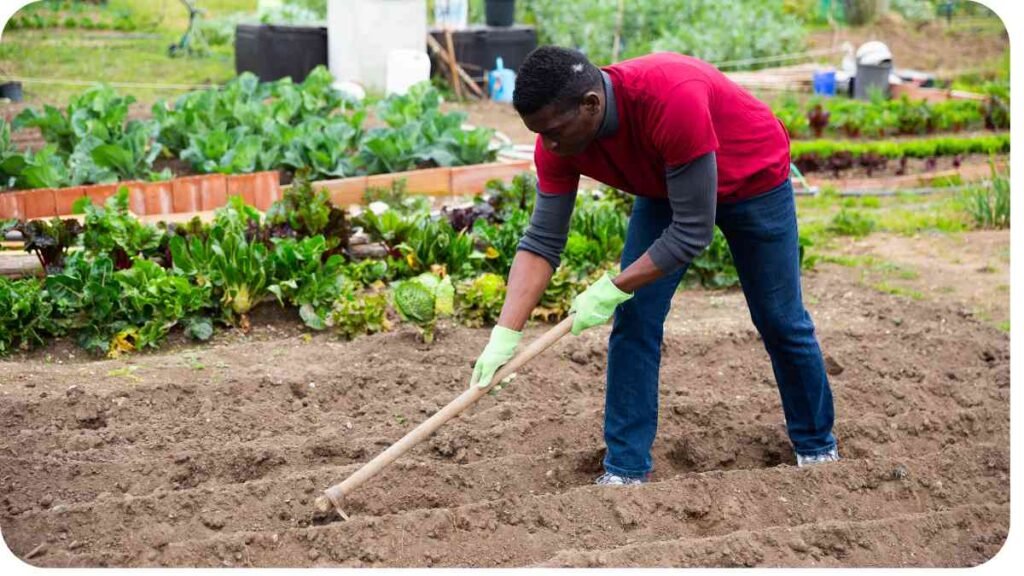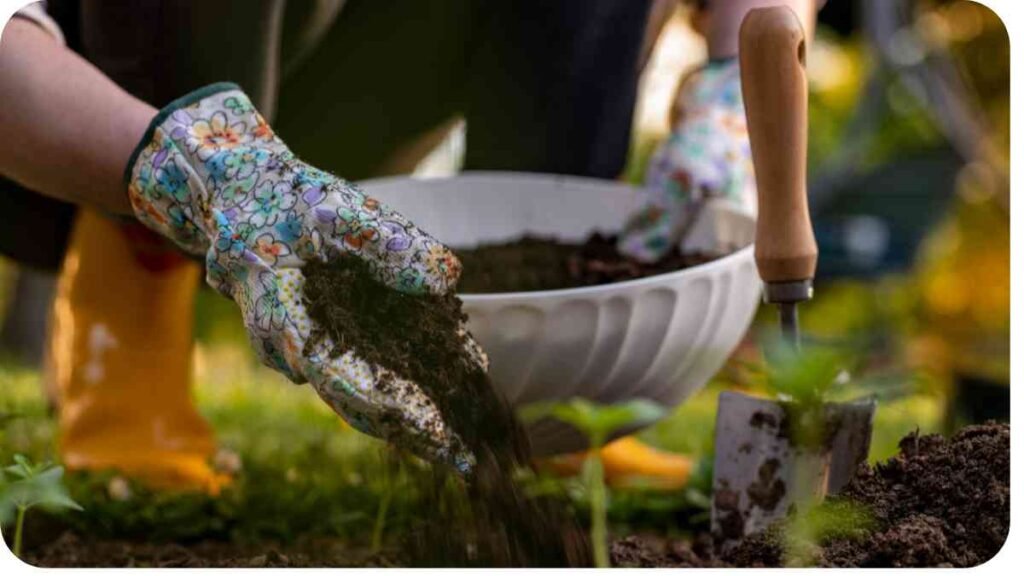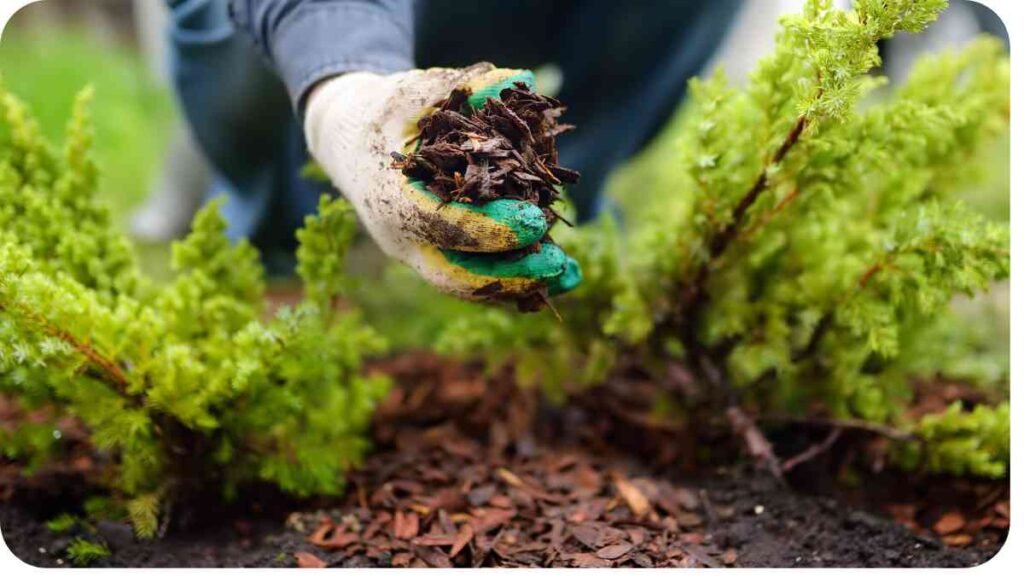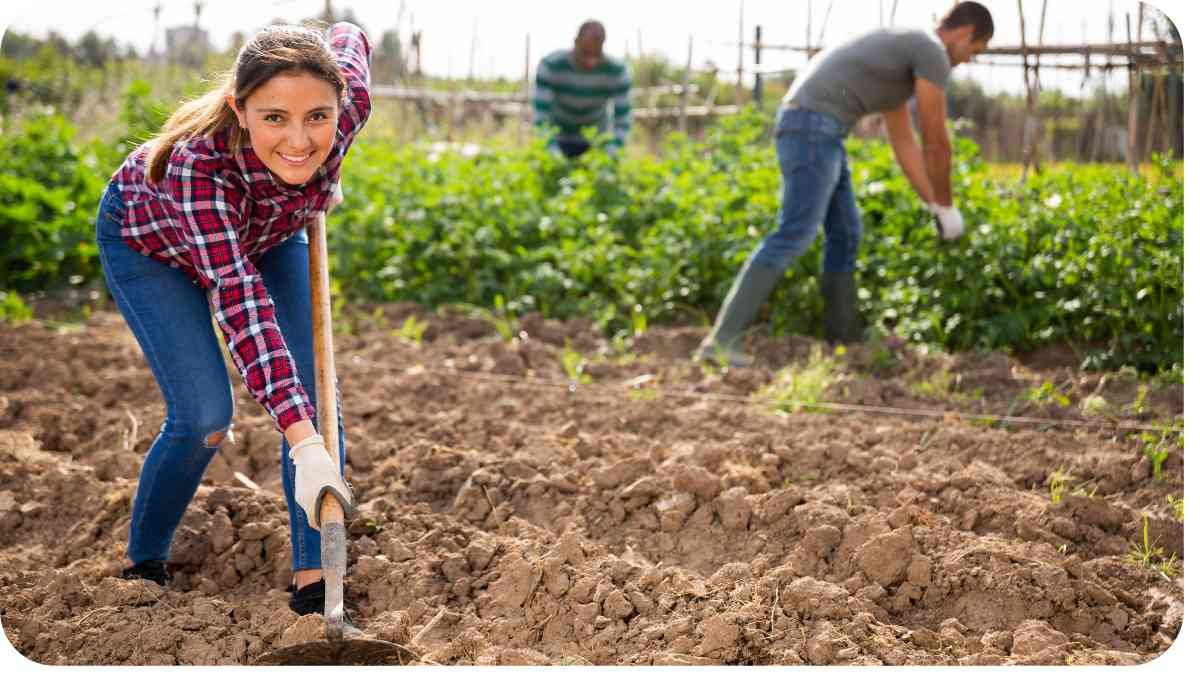Gardening tilling is a crucial step in preparing your soil for planting, but what comes next is equally important. In this guide, we’ll delve into the essential tasks and considerations for post-tilling care to ensure the success of your garden. From soil amendment to pest prevention, we’ve got you covered.
| Takeaways |
|---|
| 1. Post-tilling care is essential for maintaining soil health and garden productivity. |
| 2. Clear debris and weeds, amend soil, manage moisture, and prevent pests and diseases. |
| 3. Plan your planting layout strategically and implement sustainable practices like composting and crop rotation. |
| 4. Regular monitoring, reflection, and learning are key to becoming a successful gardener. |
| 5. By following these steps, you’ll nurture thriving plants and enjoy a bountiful harvest in your garden. |
2. Why Post-Tilling Care Matters

After tilling, your soil is primed for optimal plant growth, but it requires nurturing to maintain its health and fertility. Neglecting post-tilling care can lead to poor plant growth, nutrient depletion, and increased susceptibility to pests and diseases.
Discover the secrets to nurturing Cryptomeria Globosa Nana with expert tips and techniques. Ensure your garden flourishes with lush greenery.
Table: Benefits of Post-Tilling Care
| Benefits | Description |
|---|---|
| Enhanced Soil Structure | Allows for better root penetration and water retention. |
| Improved Nutrient Availability | Ensures plants have access to essential nutrients for growth. |
| Reduced Weed Competition | Proper care minimizes weed growth, giving your plants a competitive edge. |
| Enhanced Plant Health | Healthy soil leads to vigorous plant growth and resilience. |
3. Clearing Debris and Weeds
Once you’ve tilled your garden, the next step is to clear away any debris and weeds that may have emerged during the process. This helps create a clean slate for planting and prevents competition for nutrients and sunlight.
Table: Common Garden Debris and Weeds
| Debris/Weed | Description | Removal Method |
|---|---|---|
| Rocks | Obstacles that impede root growth and tillage. | Hand-picking or using a rake. |
| Plant Residues | Decaying plant matter that can harbor pests. | Composting or removing from the garden. |
| Annual Weeds | Weeds that complete their life cycle in a year. | Pulling by hand or using a hoe. |
| Perennial Weeds | Weeds that persist year after year. | Digging out the roots or using herbicides. |
Once the debris and weeds are cleared, your garden will be ready for the next steps in post-tilling care.
4. Soil Amendment and Fertilization

Tilling can disrupt the natural balance of nutrients in your soil, so it’s essential to replenish them before planting. Soil amendment and fertilization are key steps in this process.
Explore a comprehensive guide on caring for Cryptomeria Globosa Nana, including troubleshooting advice for addressing browning foliage. Elevate your gardening skills effortlessly.
Table: Common Soil Amendments and Fertilizers
| Amendment/Fertilizer | Description | Application Method |
|---|---|---|
| Compost | Rich in organic matter, improves soil structure and fertility. | Spread evenly over soil. |
| Manure | Provides nitrogen, phosphorus, and potassium for plant growth. | Incorporate into soil. |
| Bone Meal | High in phosphorus, promotes strong root development. | Mix into planting holes. |
| Fish Emulsion | Provides a quick source of nutrients for rapid plant growth. | Dilute and apply as a foliar spray. |
By amending your soil with the right nutrients, you’ll set the stage for healthy plant growth and abundant harvests.
5. Moisture Management
After tilling, it’s crucial to manage moisture levels in your soil to support seed germination and plant growth. Proper moisture management ensures that your plants have access to the water they need without becoming waterlogged.
Table: Methods for Moisture Management
| Method | Description | Application |
|---|---|---|
| Watering Schedule | Establish a regular watering routine based on the needs of your plants. | Water deeply and infrequently to encourage deep root growth. |
| Mulching | Cover the soil with a layer of organic mulch to retain moisture and suppress weeds. | Apply mulch around plants, leaving space around stems. |
| Drip Irrigation | Deliver water directly to the root zone, minimizing evaporation and runoff. | Install drip irrigation systems for efficient watering. |
| Rainwater Harvesting | Collect rainwater in barrels or cisterns for use in the garden during dry periods. | Place rain barrels under downspouts to capture runoff. |
By implementing these moisture management techniques, you can ensure that your plants thrive without being either parched or waterlogged.
6. Assessing Soil Condition
Regular assessment of your soil’s condition allows you to make informed decisions about its management. By understanding factors such as pH, texture, and nutrient levels, you can tailor your gardening practices to meet the specific needs of your plants.
Elevate your vegetable harvest with a beginner-friendly guide to raised bed gardening. Optimize space and yield for a bountiful harvest.”
Table: Soil Assessment Parameters
| Parameter | Description | Testing Method |
|---|---|---|
| pH Level | Measures soil acidity or alkalinity. | Use a pH testing kit or meter. |
| Soil Texture | Determines the relative proportions of sand, silt, and clay particles. | Conduct a soil texture test. |
| Nutrient Levels | Assess the concentrations of essential nutrients such as nitrogen, phosphorus, and potassium. | Soil testing by a laboratory. |
| Organic Matter | Indicates the amount of decomposed plant and animal material in the soil. | Estimate by visual inspection or testing. |
Regular soil assessment empowers you to make informed decisions about soil amendment and fertilization, leading to healthier plants and higher yields.
5. Moisture Management
Proper moisture management is essential for the success of your garden after tilling. Ensuring that your plants receive adequate water without becoming waterlogged is crucial for their growth and development.
Table: Moisture Management Tips
| Moisture Management Tips | Description |
|---|---|
| Watering Schedule | Establish a regular watering schedule based on plant needs and weather conditions. |
| Mulching | Apply mulch around plants to retain moisture in the soil and reduce evaporation. |
| Irrigation Methods | Choose appropriate irrigation methods such as drip irrigation or soaker hoses to deliver water efficiently. |
| Soil Moisture Monitoring | Use a moisture meter or simply feel the soil to determine when watering is necessary. |
By implementing these moisture management strategies, you’ll ensure that your plants have the water they need to thrive without the risk of overwatering.
Embark on a journey to cultivating success with a practical guide on no-till gardening. Foster healthy soil and sustainable practices for thriving plants.”
6. Assessing Soil Condition
Regularly assessing the condition of your soil is essential for maintaining its health and fertility. By monitoring key indicators, you can make informed decisions about soil amendment and management practices.
Table: Indicators of Soil Health
| Soil Indicator | Description |
|---|---|
| Soil Texture | Determines the proportion of sand, silt, and clay in the soil, influencing drainage and nutrient retention. |
| pH Level | Measures the acidity or alkalinity of the soil, affecting nutrient availability to plants. |
| Soil Structure | Refers to the arrangement of soil particles and aggregates, influencing water infiltration and root penetration. |
| Soil Organic Matter | Indicates the presence of decomposed plant and animal material, contributing to soil fertility and structure. |
By regularly assessing these soil indicators, you can make timely adjustments to ensure optimal growing conditions for your plants.
7. Planning Planting Layout
After tilling your garden and preparing the soil, it’s time to plan your planting layout. Strategic placement of plants based on their sunlight, water, and spacing requirements is crucial for maximizing yields and minimizing competition.
Table: Factors to Consider in Planting Layout
| Factors | Description |
|---|---|
| Sunlight Exposure | Consider the sun requirements of each plant and arrange them accordingly to optimize sunlight exposure. |
| Water Needs | Group plants with similar water requirements together to simplify irrigation and avoid overwatering. |
| Spacing | Follow recommended spacing guidelines to prevent overcrowding and ensure adequate airflow between plants. |
| Companion Planting | Take advantage of companion planting principles to maximize plant health and pest resistance. |
By carefully planning your planting layout, you’ll create a harmonious garden that promotes healthy growth and minimizes potential issues.
8. Planting Seeds or Transplants
Once you’ve finalized your planting layout, it’s time to start planting seeds or transplants. Whether you’re sowing seeds directly into the soil or transplanting seedlings, proper planting techniques are crucial for success.
Revitalize your lawn with expert tips for restoring lush, vibrant grass after a challenging season. Learn the secrets to reviving your lawn and enjoy a vibrant outdoor space year-round.
Table: Planting Guidelines
| Planting Method | Description |
|---|---|
| Direct Seeding | Sow seeds directly into the soil at the appropriate depth and spacing. |
| Transplanting | Handle seedlings carefully to avoid damaging roots and transplant at the correct depth. |
| Watering | Water newly planted seeds or transplants gently to ensure good soil contact and hydration. |
By following these planting guidelines, you’ll give your plants the best possible start and ensure healthy establishment.
9. Mulching for Moisture Retention

Mulching is a valuable practice in gardening that helps retain moisture, suppress weeds, regulate soil temperature, and improve overall soil health. After planting, applying mulch around your plants is an essential step in post-tilling care.
Table: Types of Mulch and Their Benefits
| Mulch Type | Benefits |
|---|---|
| Organic Mulch | Decomposes over time, adding organic matter to the soil and improving soil structure. |
| Inorganic Mulch | Does not decompose, providing long-lasting weed suppression and moisture retention. |
| Mulch Materials | Various materials such as wood chips, straw, leaves, grass clippings, or plastic mulch can be used. |
By choosing the right type of mulch and applying it correctly, you’ll conserve moisture, reduce weed growth, and promote a healthy garden ecosystem.
10. Pest and Disease Prevention
Preventing pests and diseases is essential for maintaining the health and productivity of your garden. After tilling, implementing preventive measures can help minimize the risk of infestations and infections.
Table: Pest and Disease Prevention Strategies
| Prevention Strategy | Description |
|---|---|
| Crop Rotation | Rotate crops annually to disrupt pest and disease cycles and maintain soil health. |
| Companion Planting | Plant insect-repellent or disease-resistant species alongside vulnerable plants. |
| Sanitation | Keep the garden clean by removing diseased plants, fallen leaves, and garden debris promptly. |
| Organic Controls | Use organic pest control methods such as neem oil, insecticidal soap, or beneficial insects. |
By incorporating these pest and disease prevention strategies into your post-tilling care routine, you’ll safeguard your garden and promote thriving plant growth.
11. Regular Monitoring and Maintenance
Monitoring your garden regularly is crucial for identifying issues early and addressing them before they escalate. After tilling, maintaining a routine of observation and maintenance will help ensure the long-term health and productivity of your garden.
Table: Key Aspects to Monitor in Your Garden
| Aspect | What to Monitor |
|---|---|
| Plant Growth | Check for signs of healthy growth, wilting, or pest damage. |
| Soil Moisture | Assess soil moisture levels regularly and adjust watering as needed. |
| Pest Activity | Look for signs of pest infestation such as chewed leaves or insect eggs. |
| Disease Symptoms | Monitor plants for signs of disease such as yellowing leaves or mold growth. |
Regular monitoring allows you to intervene promptly and address any issues that arise, ensuring optimal growing conditions for your plants.
12. Implementing Crop Rotation
Crop rotation is a beneficial practice that involves planting different crops in the same area each year to prevent soil depletion and reduce pest and disease pressure. After tilling, implementing a crop rotation plan can help maintain soil fertility and health.
Table: Crop Rotation Strategies
| Crop Rotation Plan | Description |
|---|---|
| Three-Year Rotation | Divide your garden into three sections and rotate crops between them each year. |
| Four-Year Rotation | Rotate crops over four plots, ensuring that each plot grows a different crop each year. |
| Five-Year Rotation | Plan a rotation cycle that spans five years, alternating crops to maximize soil health benefits. |
By rotating crops regularly, you’ll replenish soil nutrients, break pest and disease cycles, and promote balanced garden ecosystems.
13. Composting Organic Material
Composting organic material is a sustainable practice that enriches the soil with nutrients, improves soil structure, and reduces waste. After tilling, incorporating compost into your garden is an excellent way to nourish your plants and promote soil health.
Table: Composting Dos and Don’ts
| Composting Dos | Description |
|---|---|
| Balance of Materials | Use a mix of green (nitrogen-rich) and brown (carbon-rich) materials to maintain a healthy compost pile. |
| Proper Aeration | Turn the compost regularly to promote oxygen flow and accelerate decomposition. |
| Moisture Management | Keep the compost pile moist, like a wrung-out sponge, to facilitate decomposition. |
| Temperature Control | Monitor the internal temperature of the compost pile to ensure optimal decomposition (around 140°F). |
By following these composting dos and don’ts, you’ll create nutrient-rich compost that enhances soil fertility and supports robust plant growth.
14. Reflecting and Learning
After completing post-tilling care in your garden, take time to reflect on your experiences and learn from them. Reflecting allows you to identify successes, challenges, and areas for improvement, while learning empowers you to make informed decisions in the future.
Table: Reflection and Learning Questions
| Reflection Questions | Description |
|---|---|
| What Worked Well? | Identify successful practices or techniques that contributed to your garden’s health and productivity. |
| What Challenges Did You Face? | Reflect on any difficulties or obstacles you encountered during post-tilling care and how you overcame them. |
| What Would You Do Differently Next Time? | Consider changes or adjustments you would make based on your experiences to improve future outcomes. |
| What Did You Learn? | Reflect on the lessons you’ve gained from your gardening experiences and how they can inform your future practices. |
By engaging in reflection and learning, you’ll continuously improve your gardening skills and achieve greater success in your garden endeavors.
15. Conclusion
In conclusion, post-tilling care is essential for maintaining the health and productivity of your garden. By following the steps outlined in this guide, including clearing debris, amending soil, managing moisture, and preventing pests and diseases, you’ll set the stage for a successful growing season.
Remember to plan your planting layout strategically, monitor your garden regularly, and implement sustainable practices such as composting and crop rotation. By reflecting on your experiences and continuously learning, you’ll become a more skilled and knowledgeable gardener.
With proper post-tilling care, you’ll nurture thriving plants, enjoy bountiful harvests, and create a beautiful and productive garden oasis.
Thank you for reading, and happy gardening!
Further Reading
- Dos and Don’ts of Tilling: Explore essential tips for successful tilling practices to ensure optimal soil health and garden productivity.
- Best Practices for Tilling Garden Soil: Learn about the best practices for tilling garden soil to create an ideal environment for plant growth and development.
- What to Do After Tilling Your Vegetable Garden: Discover valuable insights and advice on post-tilling care for vegetable gardens to maximize yields and maintain soil fertility.
FAQs
What are the essential steps for post-tilling care?
The essential steps for post-tilling care include clearing debris, amending soil, managing moisture, planning planting layout, preventing pests and diseases, and implementing composting and crop rotation practices.
How often should I monitor my garden after tilling?
It’s recommended to monitor your garden regularly, at least once a week, to check for signs of plant growth, soil moisture levels, pest activity, and disease symptoms.
Can I use mulch immediately after tilling?
Yes, you can apply mulch immediately after tilling to retain moisture, suppress weeds, and regulate soil temperature. Ensure that the soil is adequately moist before mulching.
What types of materials can I compost for my garden?
You can compost various materials such as kitchen scraps, yard waste, leaves, grass clippings, and plant residues. Avoid composting meat, dairy, and oily foods to prevent odors and attract pests.
How can I prevent pests and diseases in my garden after tilling?
To prevent pests and diseases, practice crop rotation, companion planting, sanitation, and use organic pest control methods such as neem oil or insecticidal soap. Regular monitoring and early intervention are also crucial for preventing infestations and infections.

Hellen James, a seasoned author at Unified Publishers LLC, brings a wealth of expertise to diverse niches. Specializing in pet care, outdoor adventures, lifestyle, wellness, and culinary delights, Hellen crafts insightful and engaging content that unlocks the full potential of readers’ interests. Explore, learn, and thrive with Hellen James.

